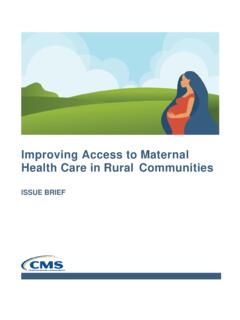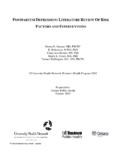Search results with tag "Postpartum depression"
Identifying and Treating Postpartum Depression
www.stjoes.caIdentifying and Treating Postpartum Depression June Andrews Horowitz and Janice H. Goodman Postpartum depression affects 10% to 20% of women in the United States and negatively influences maternal, infant, and family health. Assessment of risk factors and depression symptoms is needed to identi-fy women at risk for postpartum depression for early
The Texas Clinician’sPostpartum Depression Toolkit
www.hhs.texas.govmajor depressive episode in the postpartum period (APA, 2013). The single greatest risk factor for postpartum depression is a prior history of depression (Langan & Goodbred, 2016). It is important to note, however, that a woman without any known risk factors may develop postpartum depression.
DIAGNOSIS AND TREATMENT OF POSTPARTUM DEPRESSION
cdn.neiglobal.com•An estimated 8.5% of postpartum women are diagnosed with one or more anxiety disorders •Approximately two-thirds of women with PPD have a comorbid anxiety disorder or symptoms •Women with postpartum depression and anxiety diagnoses display poorer quality of life and their illness is slower to remit than women with postpartum depression only
Screening for Postpartum Depression in Military Women …
marcesociety.comscreening for postpartum depression, consistent with the na-tional average of 10 to 15%. Future research is needed to examine issues surrounding postpartum depression of military women. Introduction More women are serving on active duty in the U.S. military each year. Currently, it is estimated that 222,000 women
Edinburgh Postnatal Depression Scale (EPDS)
www.fresno.ucsf.edu1 (EPDS) Postpartum depression is the most common complication of childbearing. 2 The 10-question Edinburgh Postnatal Depression Scale (EPDS) is a valuable and effici ent way of identifying patients at risk for “perinatal” depression. The EPDS is easy to administer and has proven to be an effective screening tool.
P3T EXERCISE CHART TG 255X - United States Army
phc.amedd.army.milSchedule time during the exercise session for postpartum Soldiers to perform the 4-for-the-core, plank, and hip stability drills to strengthen their core muscles. Watch for symptoms of postpartum depression that may occur between 3-4 months postpartum. Encourage Soldiers that
Improving Access to Maternal Health Care In Rural ...
www.cms.govsevere maternal morbidity, and increased risk of postpartum depression. These health disparities affect American Indian and Alaska Native and women of color disproportionately. Since one in five Americans live in a rural community, including approximately 18 million women of reproductive age, it is critical that
Postpartum Depression (PPD) - aapsus.org
aapsus.org18 AmericAn JournAl of clinicAl medicine® • Spring 2009 • Volume Six, number Two Postpartum Depression (PPD) • Postpartum Panic Disorder is diagnosed if the mother experiences panic attacks for the first time in her life.
DEPRESSION LITERATURE REVIEW F ISK
www.who.intThis Postpartum Depression Literature Review of Risk Factors and Interventions, commissioned by Toronto Public Health, is a comprehensive review of the literature from 1990-2002 in four related areas: 1) risk factors for postpartum depression, 2) its detection, prevention and treatment 3) the effects of the illness
Postpartum Depression
postpartumstress.comWhat does postpartum depression feel like? ... Sometimes, self-help measures are not enough. If symptoms persist for more than two weeks, you should consider seeking professional support. Ask your healthcare provider for the name of a good therapist who specializes in the treatment
DEPRESSION LITERATURE REVIEW F ISK - WHO
www.who.intPOSTPARTUM DEPRESSION: LITERATURE REVIEW OF RISK FACTORS AND INTERVENTIONS Donna E. Stewart, MD, FRCPC E. Robertson, M.Phil, PhD Cindy-Lee Dennis, RN, PhD Sherry L. Grace, MA, PhD Tamara Wallington, MA, MD, FRCPC ©University Health Network Women’s Health Program 2003
Similar queries
Identifying and Treating Postpartum Depression, POSTPARTUM DEPRESSION, Depression, Postpartum, Postpartum Depression in Military, Military, Edinburgh Postnatal Depression Scale, United States Army, Access to Maternal Health Care In Rural, DEPRESSION LITERATURE REVIEW, Postpartum Depression Literature Review, Self, Help, FRCPC









